What are Crypto Wallets?
The crypto hardware wallet is a device to store offline digital assets like cryptocurrency, NFT, etc, and safeguard them from cyber attacks and scams.
You can buy this device online via e-commerce channels and is available in different formats, levels of complexity, device features, safety measures, and price ranges.
Users can access and control all the funds available in the blockchain account via private keys.
People require crypto hardware wallets for the safe storage of private keys offline. Keeping them offline protects them from hacking and phishing, which enhances security and ensures crypto users have full control over assets. Moreover, these hardware wallets are more affordable, with prices ranging from $50 to $150, offering users reasonable security.

Crypto hardware wallet keeps cryptocurrencies safe from cyber threats making them free from online attacks like phishing or hacking.
These wallets are easy to carry and store digital assets and secure them safely in physical objects. The form factor of these hardware wallets often resembles the credit card-sized device cards or USB drives. The portability allows users to keep their private keys securely and protect them from all cyber threats.
In a crypto hardware wallet, you can store – Bitcoins, Ethereum, Dodge Coins and tokens, Lite Coins, NFTs, and other digital assets.
Some prominent hardware wallet brands are Ledger (Ledger Nano S, Ledger Nano X), Trezor (Trezor Model T, Trezor One), OneKey, Coldcard, SafePal, and BitBox.
Types of Wallets
- Hot Wallets
These are online wallets that enable easy access and control of cryptocurrencies through a computer or mobile device. Some instances are either mobile wallet applications, software wallets, or extension wallets.
- Cold Wallets
These physical devices store cryptocurrency offline, providing further security against online threats. Users can access their funds by connecting the hardware wallet to a computer or phone via a USB port or another sort of connection.
Forms of Hardware Wallets
| Forms of Hardware Wallets | Description | Brand Examples | Key Features |
| USB Drive | A hardware wallet is a USB device that plugs into a computer or mobile device to securely hold private keys. The wallet signs transactions offline. | Ledger Nano S, Trezor,KeepKey | Portable, plug-and-play, typically supports multiple cryptocurrencies. |
| Cards | A hardware wallet is designed like a credit card, storing private keys securely and often requiring a mobile app for management. | CryptoSteel Card, Tangem Cards | Compact, convenient, and often uses NFC or QR codes for interactions. |
| Biometric Wallet | A hardware wallet that uses biometric authentication (such as fingerprint or facial recognition) to ensure safe access and transaction signature. | Solana Pay Biometric wallet, Biostar | Uses biometric data for enhanced security, often used with mobile devices. |
| OLED Screen Display Wallet | A hardware wallet with an inbuilt OLED screen that displays transaction data, allowing users visual confirmation of the transaction before signing. | Ledger Nano X, Trezor Model T | Display for verifying transaction data, helps with confidence and security in signing. |
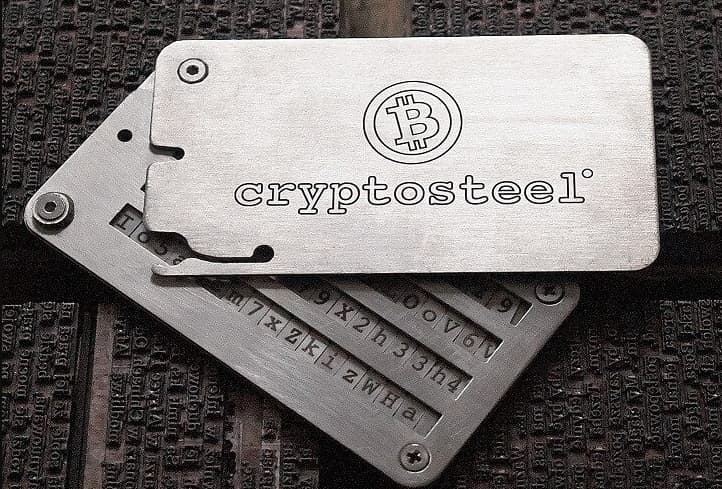
The above shows the crypto card, a hardware wallet designed like a credit card.
Uses of Hardware Wallets
- Cryptocurrency: To store cryptocurrencies, just connect your hardware wallet to your computer or phone, download a compatible application (such as Ledger Live or Trezor Suite), and transfer your coins to the wallet’s address.
- NFTs: Hardware wallets are capable of storing Non-Fungible Tokens (NFTs) as well. By linking your hardware wallet to platforms such as OpenSea or Rarible, you can securely carry out NFT transactions, guaranteeing the safety of your tokens.
- Digital Assets: In addition to crypto and NFTs, hardware wallets can also be used with other digital assets such as tokenized real estate or digital art. They assist in securely managing and storing a diverse range of assets.
How to Choose a Crypto Hardware Wallet?
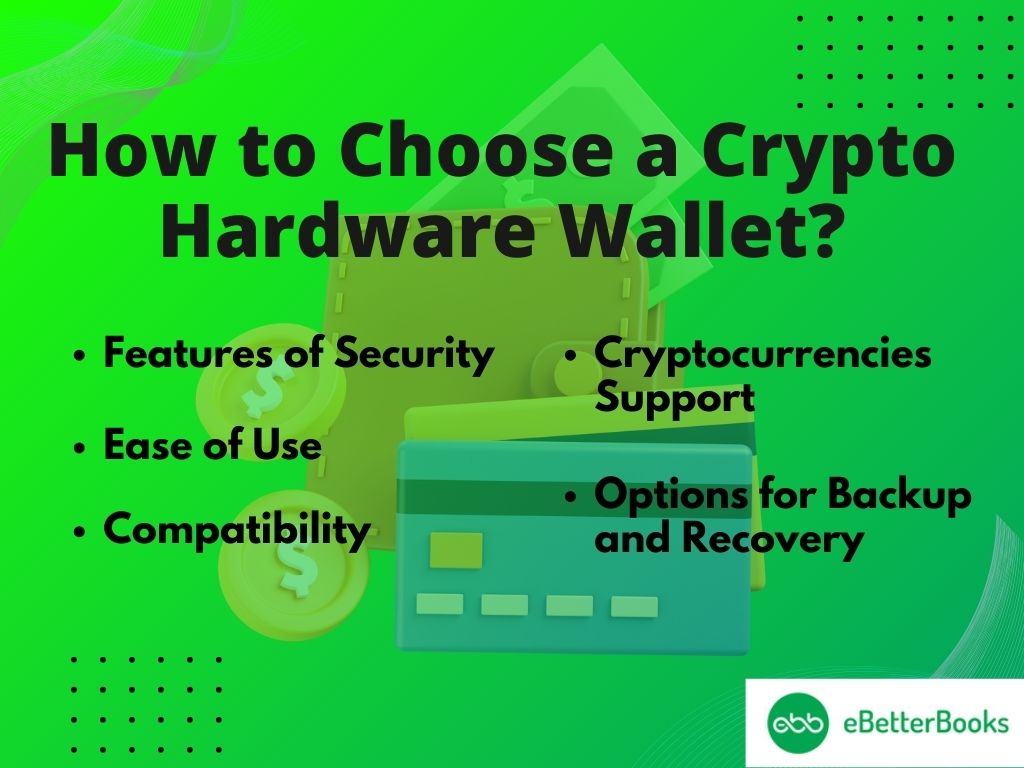
When selecting the ideal crypto hardware wallet, you must consider several aspects that fit your technical expertise, security requirements, and personal preferences. This comprehensive guide will assist you in choosing a hardware crypto wallet for storing cryptocurrencies and aid in your next crypto storage hardware wallet buying decision.
1. Features of Security
The most important consideration when selecting a crypto hardware wallet is security. To protect private keys from online dangers, look for the best crypto wallets that store them offline. PIN code protection, a backup recovery seed, and other layers like a Secure Element chip are all crucial components. To further protect your valuables, some crypto wallets additionally have self-destruct and passphrase security features.
2. Cryptocurrencies Support
Verify if the crypto wallet is compatible with the cryptocurrency you presently own or intend to maintain. While some cryptocurrency wallets are more specialized, others support hundreds of coins and tokens. Select a crypto wallet that supports a wider range of cryptocurrencies.
3. Ease of Use
When choosing a hardware crypto wallet, usability is essential. Choose a crypto wallet with a user-friendly interface, a simple setup procedure, and unambiguous instructions. Additionally, a decent crypto wallet will offer desktop or mobile apps that make managing transactions easier.
4. Compatibility
Verify whether the hardware crypto wallet works with your mobile devices (iOS or Android) and operating systems (Windows, macOS, and Linux). It should integrate easily with the exchanges and crypto management software you now use.
5. Options for Backup and Recovery
Search out wallets that provide recovery words, also known as seed phrases, and make sure the procedure is simple enough to complete to retrieve your valuables.
Cold Wallet Vs Hard Wallet
| Features | Cold Wallets | Hard Wallet |
| Definition | A cryptocurrency storage method that is offline (not connected to the internet). | A physical device used to store cryptocurrencies offline securely. |
| Security | High security, as it is not connected to the internet, prevents online hacking. | Very high security due to encryption and offline storage of private keys. |
| Accessibility | Access to funds requires manually transferring to/from online wallets. | Requires the hardware wallet device to access and sign transactions. |
| User-Friendly | Less user-friendly compared to hardware wallets, especially for beginners. | Generally user-friendly, designed for easy access and transaction signing. |
| Usage Scenario | Ideal for long-term storage or “HODLing” of crypto. | Used for secure transactions, long-term storage, or small-to-medium amounts. |
Why Do You Need a Hardware Wallet for Crypto?
Here are the main reasons why a hardware wallet is crucial:
- Security of Private Keys: A hardware wallet securely saves your private keys offline, which are required for controlling and accessing your cryptocurrency. Because private keys are required for access, their security is critical.
- Protection Against Cyberattacks: As hardware wallets function in offline mode, they are immune to phishing assaults, keyloggers, and cryptocurrency scams.
- Recovery and Backups: Hardware wallets offer full security and safety with recovery and backups even if the hardware device is stolen or lost. Without approaching any third party, the restoration process is easier.
- Control and Ownership: Having a hardware wallet gives you complete ownership of your private keys, so you don’t have to rely on centralized exchanges or third-party services.
- Compatibility Across Various Cryptocurrencies: Numerous hardware wallets can store a diverse selection of cryptocurrencies, enabling users to securely store multiple types of tokens within a single device.
Advantages and Disadvantages of Crypto Hardware Wallet
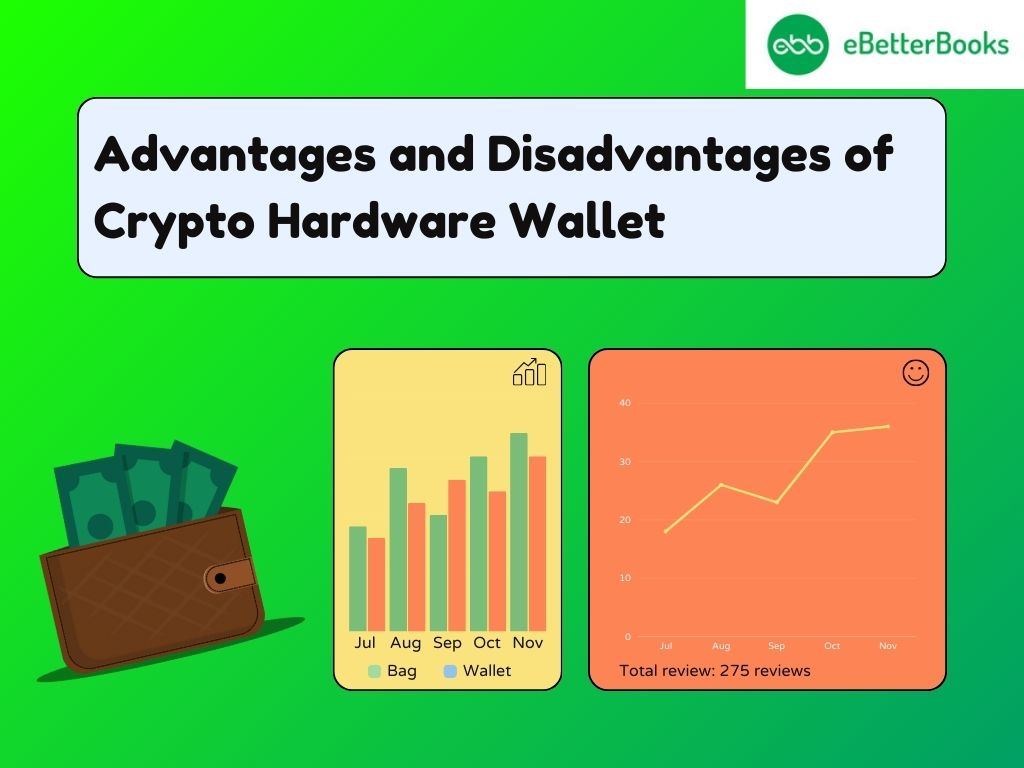
Advantages of Crypto Hardware Wallets:
- Advanced Security Features: The risk of internet hackers is lessened because the private keys are held offline. Since private keys are not made public, the risk of cyber assaults is lessened.
- Level of Control and Ownership: Because the buyer of the hardware wallet is the single owner of everything, the risk of trusting a third party is removed. As a result, the optimal level of ownership and control is achieved.
- Recovery and Backups: Because the data is encrypted offline, Crypto Hardware wallet users may quickly recover and back up all of their data. It can easily be recovered with a valid set of credentials.
- User-Friendly: Hardware wallets have simple interfaces that may be accessed via companion programs such as Ledger Live or Trezor Suite. Once set up, they provide an easy way to send and receive assets while maintaining high security.
- Multi Currency Support: Many hardware wallets support a variety of cryptocurrencies (e.g., Bitcoin, Ethereum, Litecoin), tokens, and NFTs.This gives consumers greater freedom and accessibility when managing various sorts of digital assets.
Disadvantages of Crypto Hardware Wallets
- Initial Purchase Price: Hardware wallets are rarely free, and a high-quality gadget will cost you more. Some advanced versions (with advanced features) may be considerably more expensive.
- Physical Loss or Damage: If the device is lost, damaged, or stolen, and you do not have the recovery seed safely saved elsewhere, your cryptocurrency holdings may be irretrievable. If you lose or damage your hardware wallet without a backup, you will lose access to your cash permanently.
- Transactional Speed is Limited: To sign a transaction, first link the wallet to your computer or phone. This implies that it is slower than using a software wallet that is installed on your device itself.
- Less Convenient for Frequent Transactions: If you make numerous transactions, physically connecting your hardware wallet, unlocking it, and confirming each transaction can be inconvenient compared to software wallets that are instantaneously available.
- Learning Curve: There is a small learning curve for beginners. While setting up and using the device is generally simple, new users may struggle to comprehend how to handle recovery seeds, sign transactions, and interact with the wallet.
Private Security Keys for Securing Crypto Wallets
Your private keys are the most critical component ensuring the security and control of your digital assets in cryptocurrency. Simply put, a private key is a unique cryptographic code that allows you to access or manage the given cryptocurrency in your wallet; it can be thought of as the “password” to your funds, and whoever has the private key owns the associated assets. This means the security of private keys is critical when it comes to the security of your cryptocurrency.
Theft is the most significant threat related to private key management. Someone can steal your funds or move them if he or she gains access to your private key. Reversing these transactions in most blockchain networks is impossible, so it is important to keep private keys secure from malicious actors. One of the effective ways to keep private keys safe is the storage of private keys offline, which is what most hardware wallets do. Hardware wallets ensure that private keys are kept offline and beyond hackers’ reach through online methods such as phishing, malware, or hacking attacks.
Private keys should not be stored in digital forms that are online-based like online wallets or exchanges because they are still susceptible to risks there. Store your private keys using cold storage products like hardware wallets, and you will sleep tight knowing your crypto assets won’t be stolen from you.
Configure or Set Up a Hardware Wallet
- Setting up the Hardware Wallet is relatively easy and yet essential to the security of your cryptocurrency; to set it up safely, follow these steps:
- Unbox and Connect: First, unbox your hardware wallet, such as a Ledger Nano X, or Trezor Model T. Connect to your computer or mobile device using the USB cable or Bluetooth connectivity (depending on the type of wallet).
- Install Companion App: Download and install the proper companion app to your wallet. In the case of some best crypto wallets, for example, Ledger uses Ledger Live, while Trezor uses Trezor Suite. The app will walk you through the setup.
- Create a PIN: When your crypto wallet is connected, you’ll be asked for a PIN code. A PIN code adds an extra security step which will be requested every time you make use of the wallet.
- Backup Recovery Word Phrase: The crypto wallet will generate a recovery phrase, usually 12 or 24 words. Record it on paper and store it in a secure place. This phrase is the key to recovering your wallet if lost or damaged.
- Install Apps and Transfer Crypto: After installing, you install the necessary cryptocurrency apps (e.g. Bitcoin, Ethereum) from the wallet’s user interface. You can then send funds to your hardware crypto wallet by copying the wallet address for use on transactions.
Crypto Hardware Wallet is Lost or Stolen
Don’t panic if your crypto hardware wallet is stolen. Recover your funds in a new wallet from the recovery seed phrase securely. The reason for having it is that it gives you access to your private keys and ensures that your crypto assets can be restored. The recovery phrase, therefore, needs to be kept off-line and must be stored in a safe place other than the hardware wallet itself. This way, no one can seize the hardware wallet and lose access to your crypto permanently. That’s why its backup needs to be kept and protected from unauthorized access. Furthermore, if you suspect that your wallet has been lost or perhaps stolen, then you should transfer your funds to another wallet as soon as possible to prevent any possibility of fraudulent transactions taking place.
Free Crypto Hardware Wallets
A paper wallet is an offline type of storing cryptocurrency that is available free of cost. These wallets were popular when cryptocurrency was not famous. Storage technology has enhanced, but paper wallets remain a reasonable mode to store private keys safely. It is comprised of a piece of paper holding your private key and public key. This kind of wallet is one of the most basic, yet highly secure, methods of storing crypto because it is offline, which protects it from attacks online, hacking, or malware.
Private key security is printed on the paper and thus a single key is required in order to access the cryptocurrency funds. Provided the paper is kept safe from unwanted access, it provides a further layer of security. The user needs to be very sure to not take or hold digital prints or scans of your wallets because hackers can alter those pictures anytime.
Unlike most hardware Crypto wallets that use QR codes or have data transfer, paper wallets are completely offline with no digital data storage, and hence extremely resistant to hacking via a remote perspective.
Paper wallets print the recovery phrase on the side of the private key, and in case you misplace the wallet, one can recover their assets using the recovery phrase.

The above image gives a glance at how a paper wallet looks.
Is Coinbase Wallet Secure?
Coinbase Wallet is generally considered a secure wallet with a good number of features designed to protect users from loss of funds and, most importantly, loss of private keys; this is a non-custodial wallet, thereby putting users in complete control of their private keys kept locally on their devices. Coinbase Wallet itself also uses end-to-end encryption to secure user-sensitive information and back up their wallets into a recovery phrase, meaning if the device holding the Coinbase Wallet is lost or damaged, recovery of the wallet files is possible. Users can also set up biometric authentication (fingerprint or facial recognition) for tighter security while accessing the wallet via mobile devices.
However, Coinbase Wallet itself, like any wallet software, has risks. In short, the security of your assets relies heavily upon how well you manage your private keys and recovery phrases. If someone can access your recovery phrase or device, they could access your funds. Despite the various protective measures provided by Coinbase Wallet, the onus of safeguarding the keys ultimately rests on the user while remaining wary of phishing attacks or a rogue app. If stronger protection is desired, one should consider hardware wallets such as Ledger or Trezor, that store keys strictly offline, therefore protecting them from possible online assaults.
What is the Safest Hardware Wallet Bitcoin?
It’s vital that a hardware wallet for Bitcoin not only holds private keys securely online and offline but also has strong encryption technology and a Secure Element/SE chip to store the private keys and protect them from both physical and online attacks.
Some of the most recognized Bitcoin security options are:
Ledger Nano X is one of the most popular and trust-based hardware wallets for Bitcoin and other cryptocurrencies. It stores private keys in a Secure Element chip (ST33), preventing physical and online attacks. It supports Bluetooth connectivity for mobile use while maintaining a high level of encryption. When the wallet is lost or damaged, the recovery phase helps to restore it.
Another popular option that is quite safe and reliable for Bitcoin storage is the Trezor Model T. It also has a touch screen, which will undoubtedly make its usage much handier. It supports a number of cryptocurrencies, including Bitcoin. Trezor security features include additional protection through a passphrase and the use of open-source code that allows its community to audit its security.
Both wallets are established and have created a formidable reputation in the crypto community. It is imperative to keep the recovery phrase and the PIN secure and avoid touching the wallet on a compromised device, as this is the ultimate guarantee of security.
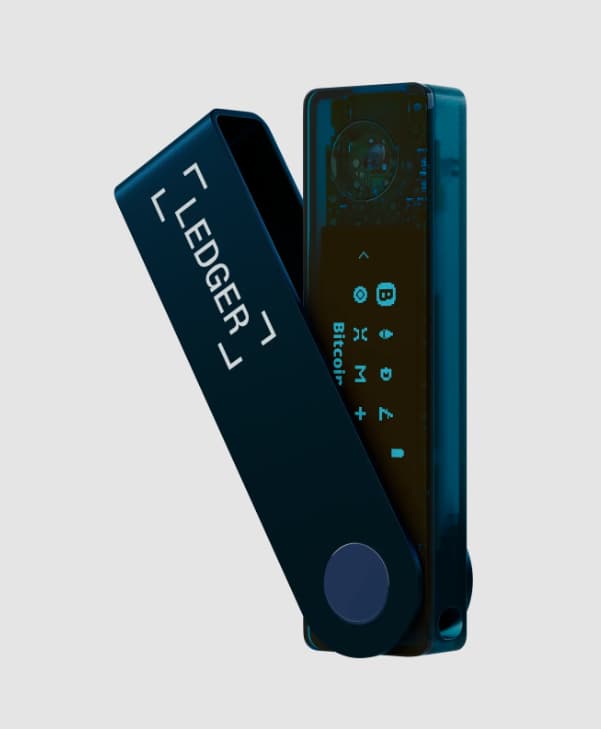
The image shows the Ledger Nano X, a hardware wallet that securely keeps the private keys offline.
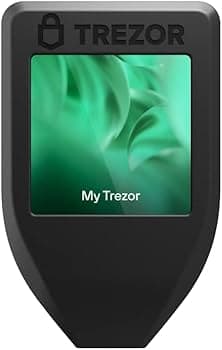
The image shows the Trezor Model T, a hardware wallet that securely keeps the private keys and has a digital display.
What is the Safest Hardware Wallet Ethereum?
The Ledger Nano X and the Trezor Model T are among the safest hardware wallets for Ethereum and both retain high-level security features intended to strengthen the assets stored within. The Ledger Nano X visually enhances its private key storage solution by having its information secured within a Secure Element (SE) chip, and also very explicitly mentions that this chip is designed to keep it tamper-proof. It is also Bluetooth-enabled and allows unrestricted mobile use without compromising security. It has a recovery phrase to restore your wallet in case of loss or damaged devices.
Trezor Model T, concerning private keys, provides one option for storing them offline and also supports Ethereum and various other cryptocurrencies. It features a touch display, a passphrase, and a recovery option through a seed phrase. Both wallets can be trusted not only for the robustness of their encryption and ease of use but also for the hardshell provided for advanced security. These are the prime picks when it comes to safely storing Ethereum. For the safety of one’s holdings, it is indeed very crucial that a recovery phrase be safely stored so as not to induce a risk.
What is the Safest Hardware Wallet Dogecoin?
Ledger and Trezor are two popular wallets reputed among Dogecoin users to be safe hardware wallets that provide solid assurance of high-level security for your assets.
Ledger securely keeps private keys offline, putting them beyond the reach of online threats. You can check your Dogecoin balance in real time using the Ledger Live app, see transaction histories, and make transactions safely and with ease. This cold storage wallet is protected against any malicious attacks while allowing the user to keep track of his/her coin holdings easily.
Trezor on the other hand is also a secure hardware wallet; it stores your private keys securely offline. Trezor provides hard encryption for transactions and offers you a straightforward user interface to manage your Dogecoin. It gives cold storage and allows recovery using a seed phrase. Thus, both physical and digital threats to your crypto wallets are prevented by it.
Ledger and Trezor remain rated as one of the safest hardware wallets for Dogecoin because of all the superior security measures, with dusty reach for your private keys, that perfect your Huobi deposit for long cryptocurrency storage.
Can I Use a Wallet Without a Bank Account?
As the software wallet does require an internet connection, a software wallet would also not need you to create a bank account number. Hardware wallets like Ledger and Trezor allow you to securely store your crypto assets in an offline manner, and no bank would probably appear in this scenario. The cold storage and other hardware wallets physically isolate the private keys in an offline environment; therefore, these wallets protect your funds against online threats. In conclusion, crypto wallets can be used effectively for receiving, storing, and sending digital currencies like Bitcoin, Ethereum, and Dogecoin any other coin that is not linked to any bank account number or bank.
However, software wallets do not need bank accounts either, even though they do require internet access because you can manage crypto assets and funds. You normally can follow up on fund balance and transactions on your wallet apps or certain platforms like Ledger Live and Trezor’s interface. However, if you’re converting cryptocurrency into fiat money, you might need that link up to a bank account number or have a fairly well-established crypto exchange that’ll enable you to receive crypto and transfer it back into fiat.
Conclusion
In a nutshell, crypto hardware wallets provide outstanding security for digital assets because their private keys are kept off and out of the domain of threats posed by online activities. Though they may involve specific investment and configuration complexity, command over private keys, support for multiple cryptocurrencies, and recovery options make them priceless for long-term asset protection. Whether it is premium devices like Ledger or Trezor, or free solutions like paper wallets, they all furnish peace of mind for the users of cryptocurrencies.
Frequently Asked Questions
What is the Difference Between a Hot Wallet and a Cold Wallet?
Hot wallets are online wallets that are easily accessible through your computer or mobile device. They are convenient for frequent transactions but are more vulnerable to cyber threats. And A Cold wallets are offline physical devices that provide a higher level of security for long-term storage of digital assets, as they are not connected to the internet and are less susceptible to hacking.
Why Should I use a Hardware Wallet?
A hardware wallet provides better security for your digital assets by keeping your private keys offline. It protects you from online threats like phishing attacks and malware, offering peace of mind that your funds are safe.
What Happens if my Hardware Wallet is Lost or Stolen?
If your hardware wallet is lost or stolen, you can still recover your funds using the backup recovery phrase (seed phrase) that you created during setup. It’s important to keep this phrase secure and stored separately to avoid losing access to your assets.

